Endocrinology Part 2
1/105
Earn XP
Description and Tags
10/7/25 (from video lecture)
Name | Mastery | Learn | Test | Matching | Spaced |
|---|
No study sessions yet.
106 Terms
What are the two hormones of the posterior pituitary gland (aka neurohypophysis)?
oxytocin (OT) and antidiuretic hormone (ADH) or vasopressin
(Posterior pituitary) What does oxytocin do?
induces contraction of smooth muscle (ex. mammary gland - milk let down + uterus)
(neurohypophysis) What are the examples given for the function of oxytocin?
milk let down (mammary gland - physical stimulation stimulates oxytocin release, other things can also elicit same response such as milking preparations)
in uterus, causes fetus expulsion (oxytocin released, stimulated by cervical stretching)
(PP-neurohypophysis) antidiuretic hormone/vasopressin is released due to what?
increased blood osmolality (conc. of dissolved substances)
decrease in blood pressure
(both are related to hydration status)
(PP-neurohypophysis) antidiuretic hormone/vasopressin acts to do what?
retain water at the kidney and constriction of blood vessels (vasopressin) (helps with homeostatic control of the body)
(hypothalamo-pituitary axis) the anterior pituitary is historically known as what?
master gland
(hypothalamo-pituitary axis) the anterior pituitary is under the control of what?
hypothalamus (also a master gland)
(hypothalamo-pituitary axis) the anterior pituitary secretes what?
large number of hormones with a wide range of effects
(hypothalamo-pituitary axis) what do you call several hormones that affect other glands to produce their own hormones?
trophic or tropic hormones
(hypothalamo-pituitary axis) the hypothalamus is a crucial interface between what two systems?
nervous and endocrine (can have positive and negative feedback)
(hypothalamo-pituitary axis) sensory information from the hypothalamus regulates what?
endocrine (pituitary gland)
(hypothalamo-pituitary axis) the axes (plural) focus on the connection between the hypothalamus and the what?
anterior pituitary
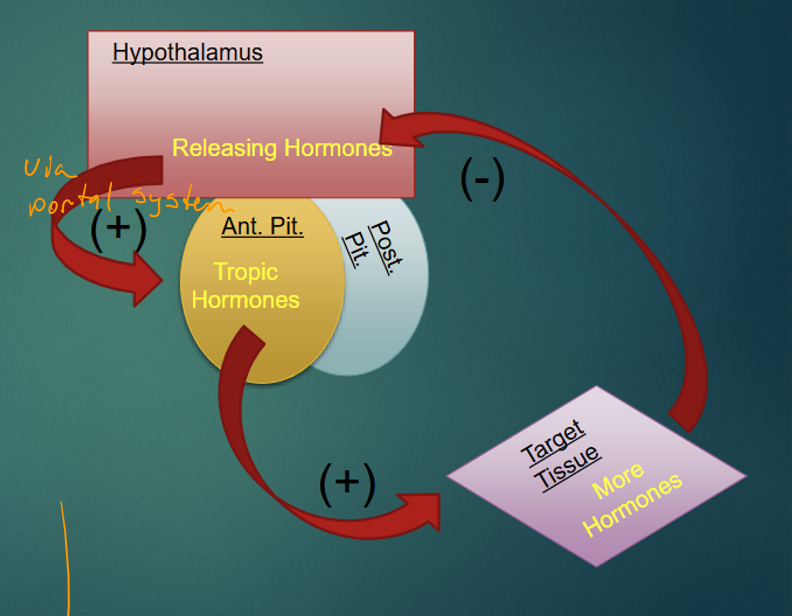
What are the three important hormones you should know relating to the hormones of the anterior pituitary (adenohypophysis)?
adrenocorticotropic hormone (ACTH)
thyroid stimulating hormone (TSH)
growth hormone (GH; somatotropin) (already discussed in bones)
(extra hormones include: prolactin and gonadotropins (LH and FSH))
What are the three hormones of the hypothalamic pituitary adrenal axis (HPA)
corticotropin releasing hormone (CRH) (in hypothalamus)
adrenocorticotropic hormone (ACTH)
glucocorticoids (ex. cortisol)
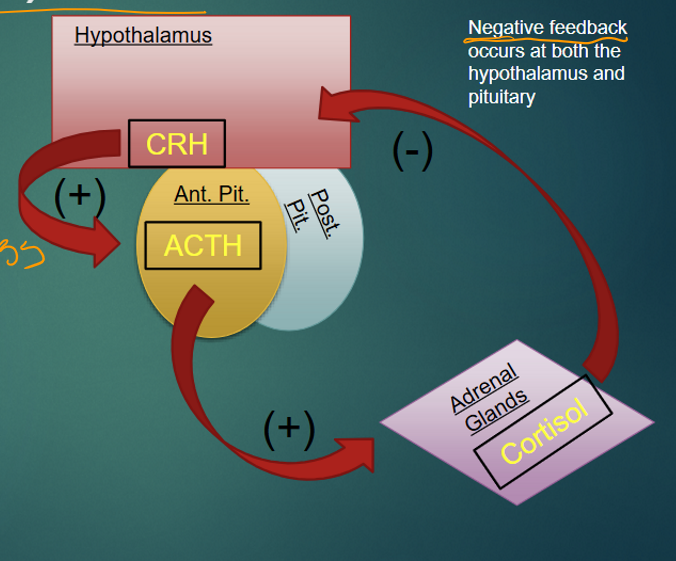
(hypothalamic pituitary adrenal (HPA) axis) corticotropin-releasing hormone (CRH) comes from where?
hypothalamus
(hypothalamic pituitary adrenal (HPA) axis) What does the release of corticotropin-releasing hormone (CRH) do?
regulates CRH (& ACTH) very complex
(hypothalamic pituitary adrenal (HPA) axis) Where does the adrenocorticotropic hormone (ACTH) come from?
anterior pituitary
(hypothalamic pituitary adrenal (HPA) axis) What is the secretion of adrenocorticotropic hormone (ACTH) stimulated by?
stress of the animal
(hypothalamic pituitary adrenal (HPA) axis) What kind of feedback does ACTH and glucocorticoids have?
negative
(hypothalamic pituitary adrenal (HPA) axis) Where does adrenocorticotropic hormone (ACTH) travel to?
adrenal glands (close to kidneys)
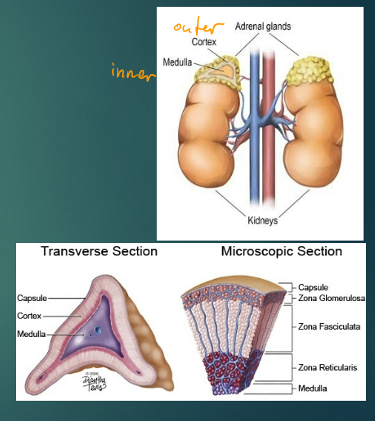
(hypothalamic pituitary adrenal (HPA) axis) What are the three zones of the cortex (outer region)?
zona glomerulosa (outermost), zona fasciculata, zona reticularis (all secrete steroid hormones)
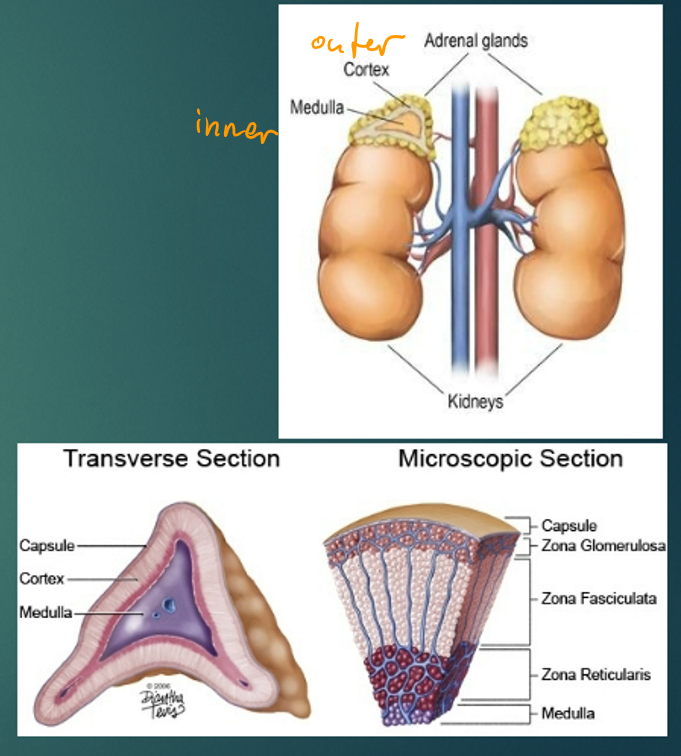
(hypothalamic pituitary adrenal (HPA) axis) Where does adrenocorticotropic hormone (ACTH) travel to to stimulate the zona fasciculata and zona reticularis?
adrenal cortex
(hypothalamic pituitary adrenal (HPA) axis) The adrenocorticotropic hormone (ACTH) travels to the adrenal cortex to stimulate what?
zona fasciculata and zona reticularis
(hypothalamic pituitary adrenal (HPA) axis) After ACTH travels to the adrenal cortex and stimulates the zona fasciculata and zona reticularis, what is synthesized and secreted?
glucocorticoids (1o cortisol and corticosterone)
The adrenal glands, which are close to the kidneys, produce hormones of the what?
adrenal cortex
What does the zona glomerulosa secrete as one of the hormones from the adrenal cortex?
mineralocorticoids (1o aldosterone) (NOT regulated by ACTH)
What does mineralocorticoids (1o aldosterone) regulate?
Na and K balance and 1o controlling loss in urine
What system, that helps release aldosterone, is controlled by mineralocorticoids (1o aldosterone)?
renin-angiotensin system and chemical messengers (urinary system)
What is the inner region of the adrenal glands called?
medulla
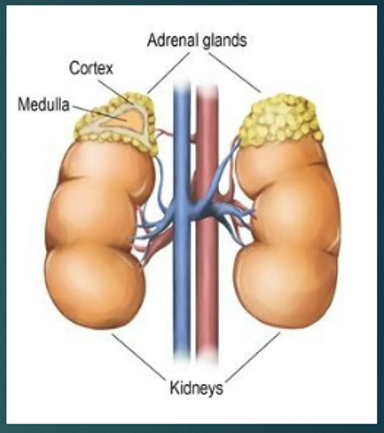
Cells of the medulla (inner region of adrenal glands) secrete what?
epinephrine (80%), norepinephrine (20%)
When does the medulla (inner region of adrenal glands) release epine. and norepinephrine?
during times of stress
What system are the cells from the medulla in the adrenal glands part of?
sympathetic nervous system (autonomic) (NOT part of hypothalamic pituitary adrenal (HPA) axis)
What are the three major hormones of the hypothalamic pituitary thyroid (HPT) axis?
thyrotropin-releasing hormone (TRH), thyroid-stimulating hormone (TSH), thyroid hormones (T3 and T4)
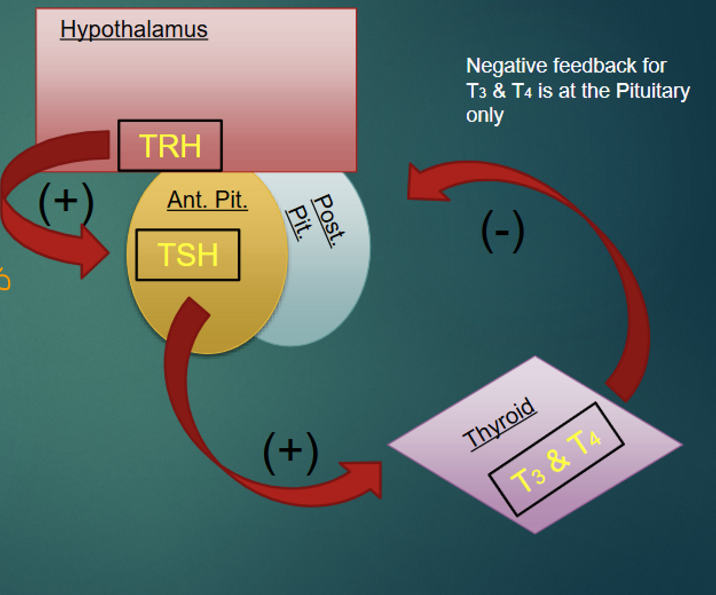
What is the thyroid-stimulating hormone (TSH) also known as?
thyrotropin
What does thyrotropin (thyroid stimulating hormone) act on?
receptors
What does thyrotropin (thyroid-stimulating hormone) target?
thyroid
What two things does thyrotropin (thyroid-stimulating hormone (TSH)) release?
thyroxine (T4) and triiodothyronine (T3)
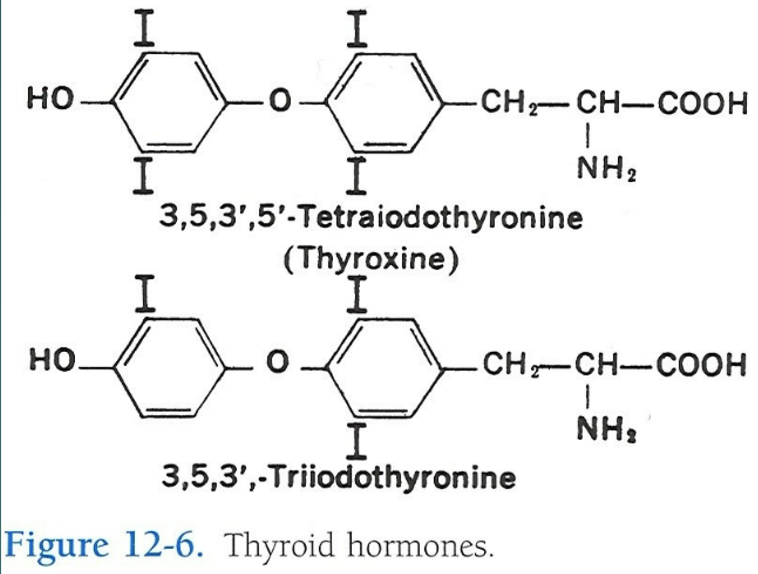
(hypothalamic pituitary thyroid (HPT) axis) What are thyroxine (T4) and triiodothyronine (T3) considered to be?
amine hormones
What do the numbers 3 and 4 refer to in T3 and T4 in triiodothyronine and thyroxine?
the number of iodine in structure
What are T3 (triiodothyronine) and T4 (thyroxine) necessary for?
growth in young animals
What do thyroxine (T4) and triiodothyronine (T3) regulate?
basal metabolic rate in adults
(HPT axis) What does the thyroid-stimulating hormone (TSH) stimulate?
thyroid gland
(HPT axis) the thyroid-stimulating hormone (TSH) is associated with what?
trachea and larynx
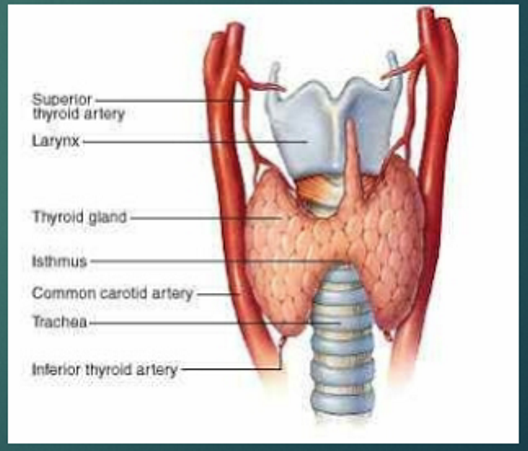
(HPT axis) in most animals (not pigs) what does the thyroid gland look like?
two distinct lobes connected by an “isthmus”
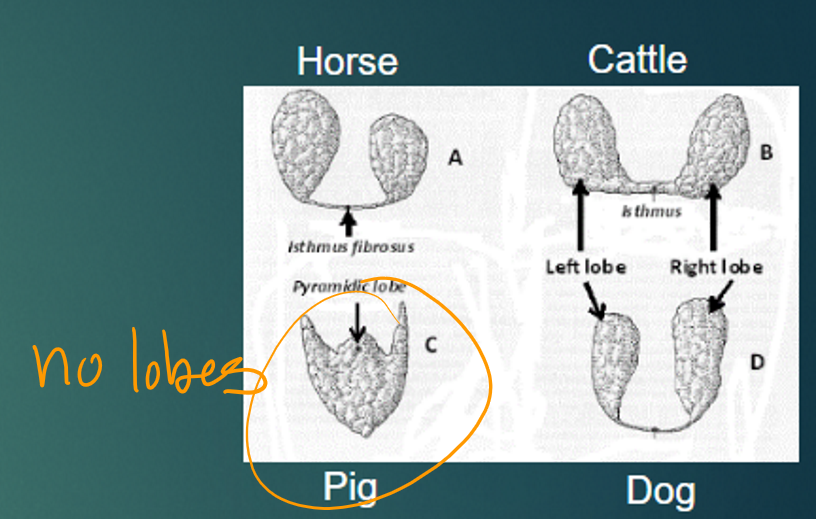
(HPT axis) What are the two lobes of the thyroid gland connected by?
isthmus
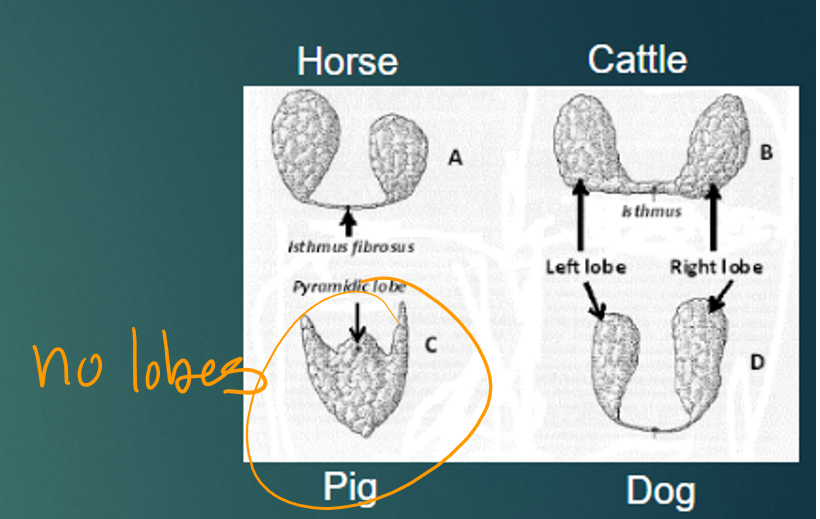
(HPT axis) What kind of blood is there from the branches of the carotid that is associated with the parathyroid glands?
arterial
(HPT axis) Arterial blood from the branches of what is associated with the parathyroid glands?
carotid
(HPT axis) the thyroid gland, microscopically consists of what?
follicles
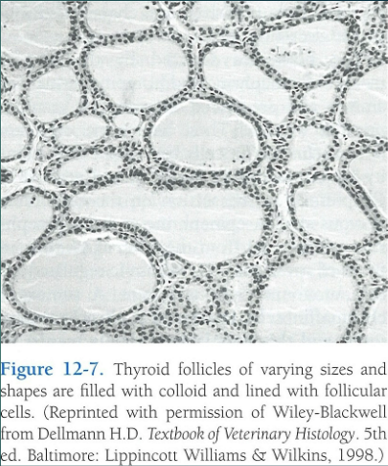
(HPT axis) What kind of tissue is associated with the thyroid gland?
simple epithelium (cuboidal or columnar)
(HPT axis) What is the thyroid gland filled with?
gel-like fluid called “colloid”
What does the gel-like fluid, colloid, in the thyroid gland consist of?
protein-iodine complex called “thyroglobulin”
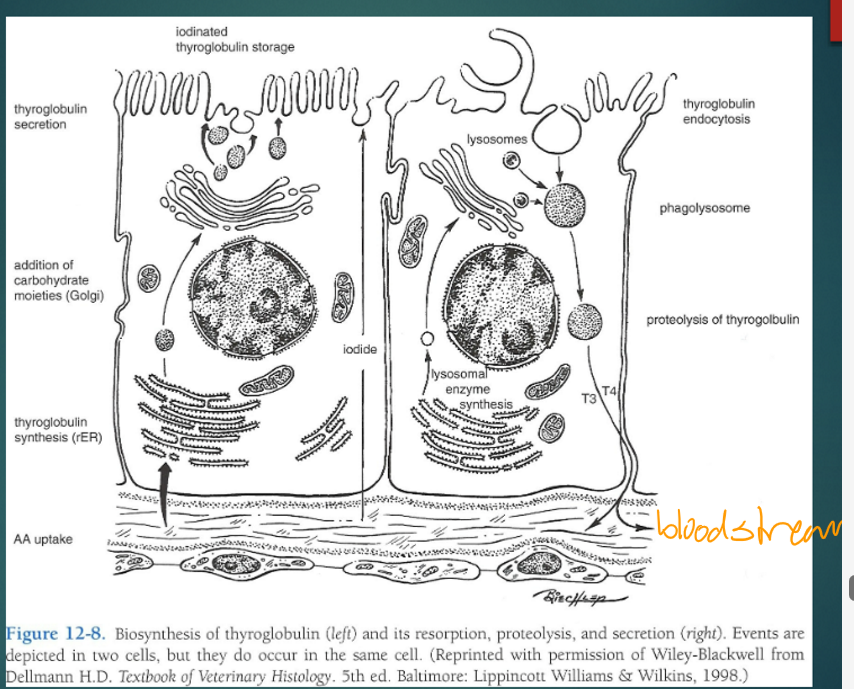
What is stored in the colloid (fluid in thyroid gland) as part of thyroglobulin?
T3 and T4 (unique storage for endocrine glands)
(HPT axis) T3 and T4 hormones circulate in what and are bound to what?
blood, proteins
(HPT axis - T3, T4) Body fluids are not bound so they are subject to what?
degradation
(HPT axis) What is greater in the blood, T3 or T4?
T4
(HPT axis) Why is there a greater amount of T4 in blood than T3?
affinity to protein is greater, so there is more of it in the blood
(HPT axis) What do the receptors have a greater affinity for, T3 or T4?
T3
(HPT axis) What can T4 be converted into?
T3 cells
(HPT axis) What is considered more biologically important, T3 or T4?
T3 (it’s more active)
(HPT axis) Almost ALL tissues have receptors for what?
T3 and T4 (ubiquitous)
(HPT axis) T3 and T4 are essential for what?
young growing animals (skeletal and nervous tissue)
(HPT axis) T3 and T4 decrease what?
physical and mental development (for young growing animals)
(HPT axis) What are the general effects of T3 and T4 on adults?
increase O2 consumption
increase heat production (chronic cold stress increases TSH)
increase use of carbs and lipids
increase basal metabolic rate (BMR)
(HPT axis) What do you call the opposite of T3 and T4 effects on adults: weight gain, cannot tolerate cold, depression, tired, etc.?
hypothyroidism (underactive)
What are scattered microscopically among the follicles of the thyroid gland?
C cells
What do C cells do in the follicles of the thyroid gland?
produce calcitonin (a peptide that decreases blood calcium levels)
What are the effects of the calcitonin produced by the C cells in the follicles of the thyroid gland?
inhibits osteoclasts and negative feedback directly on C cells by Ca concentrations (this is NOT controlled by TSH)
What are the important hormones for the hypothalamic pituitary somatotropic (HPS) axis?
growth hormone-releasing hormone (GHRH), growth hormone-inhibiting hormone (GHIH), growth hormone (GH), and insulin-like growth factors (IGF)
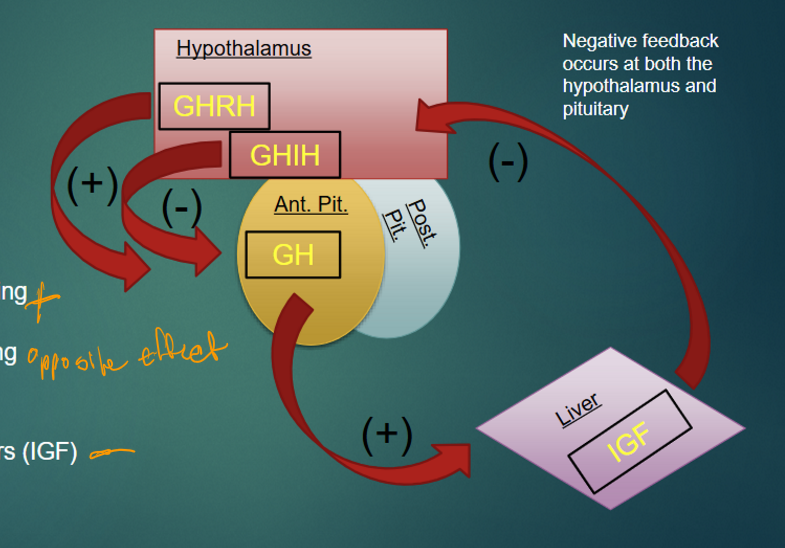
(HPS axis) What is growth hormone (GH) also known as?
somatotropin
(HPS axis) The blood concentration of growth hormone is greatest where?
in young animals (older animals can release GH also tho)
(HPS axis) growth hormone regulates metabolism during:
starvation, low blood glucose levels, and hibernation
(HPS axis) What are the causes of the release of growth hormones?
protein breakdown (muscle), decrease glucose use by muscle cells, increase mobilization of fatty acids from adipose tissue
(HPS axis) What is the role of growth hormone (somatotropin) in the growth of younger animals?
little direct effect on bone and cartilage and causes other factors to act (somatomedins - IGF)
(HPS axis) growth hormone acts on the liver to release what?
somatomedins (insulin-like growth factors - IGF-1 and IGF-2)
(HPS axis - GH) Somatomedins are released by what around growth plates?
liver and cells
(HPS axis - GH) What are the effects of IGF-1 and IGF-2 (insulin-like growth factors)?
have negative feedback to the hypothalamus and the anterior pituitary
(hormones of adenohypophysis - AP) the what of growth hormone varies by species?
amino acid sequence
(hormones of adenohypophysis - AP - GH) Recombinant DNA technology led to what?
human rGH (used to treat pituitary dwarfism) and bovine (rBST - increases lactation and feed efficiency)
(endo glands) What is the small endocrine tissue near the thyroid?
parathyroid glands
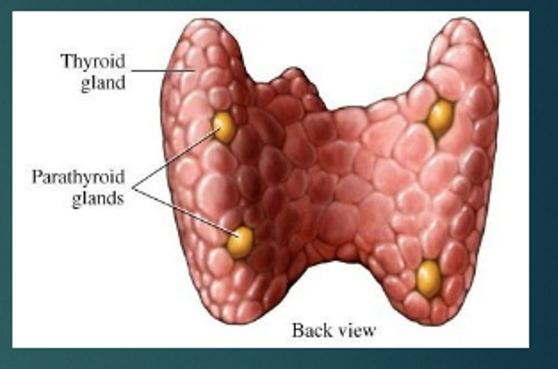
(endo glands) Most animals have how many parathyroid glands?
two pairs (4 total)
(endo glands) Where are the 4 parathyroid glands located?
one pair outside the thyroid (external parathyroids) and another buried in the thyroid (internal parathyroids)
(endo glands) What cells produce the parathyroid hormone (PTH)?
chief cells
(endo glands) What are chief cells?
major controller of blood calcium and phosphorus and activates osteoclasts to elevate calcium
(endo glands) the parathyroid hormone (PTH) from the parathyroid gland, is a what?
peptide
(endo glands) with the parathyroid hormone (PTH), diets with decrease what are common?
calcium (except grain diets, they have increased PTH - bone deformities - osteoporosis)
(endo glands) What is “Bran disease” or “bighead” in horses that are fed bran?
involved with parathyroid hormone, decalcified bone replaced with soft tissue, especially flat bones (head enlarges)
(endo glands) Where are pancreatic islets located?
in pancreas, adjacent to the small intestine
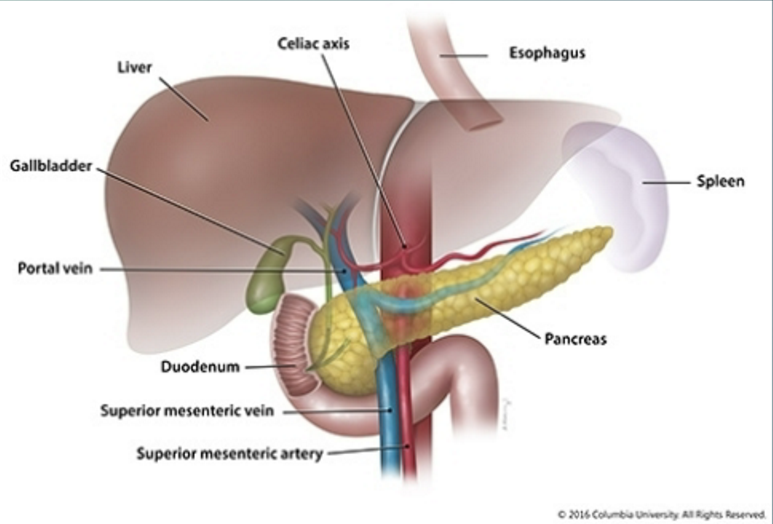
(endo glands) What is also an important exocrine gland (digestive enzymes)?
pancreatic islets/pancreas
(endo glands) What is located throughout the pancreas?
masses of cells (pancreatic islet cells - islets of Langerhans)
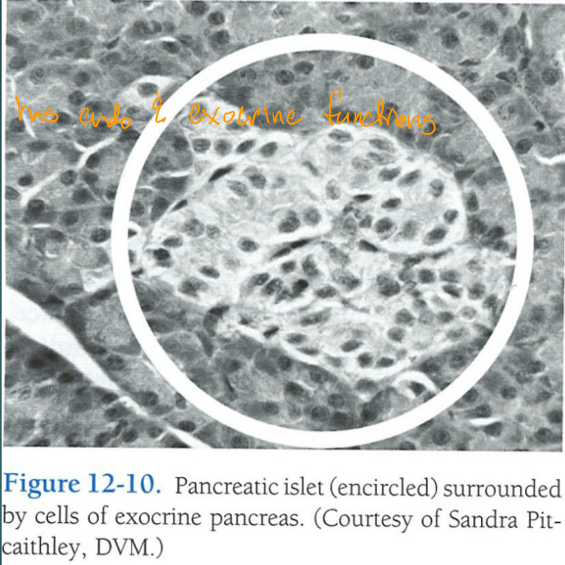
(endo glands) What are two of the cells of the pancreatic islets you should know (although there are several types)?
a-cells (glucagon) and B-cells (75% of all islet cells, insulin)
(endo glands) What do B-cells of the pancreatic islets do?
sensitive to increase blood glucose, then release insulin
(endo glands) in pancreatic islets, insulin (β-cells) decreases blood glucose by:
increase glucose uptake of cells
stimulates glycogen synthesis (liver and muscle)
stimulates protein synthesis by muscle
stimulates deposition of lipids in adipose tissue
(endo glands) What is anabolism in pancreatic islets?
building things in animal
(endo glands) Describe the two types of diabetes mellitus from pancreatic islets?
type 1 (decrease in insulin - juveniles)
type 2 (resistance to insulin, decrease in receptors - adult onset (less receptors))
(endo glands) in pancreatic islets, glucagon (a-cells - decrease in blood glucose) causes:
liver to break down glycogen
adipose to release fatty acids
liver to make glucose
(endo glands) What is the epiphysis also known as?
epiphysis cerebri or pineal gland
(endo glands) what kinda animals have an epiphysis (pineal) gland?
fish, amphibians, and some reptiles
(endo glands) What is an epiphysis (pineal) gland in non-mammals?
photoreceptors “third eye” that set daily and annual cycles based on photo period
(endo glands) Where is the epiphysis (pineal) gland located in mammals?
deep in brain case